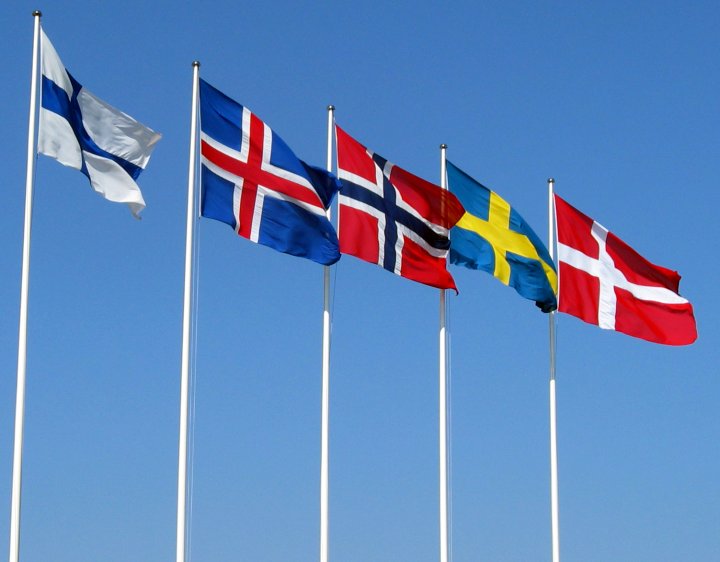 |
| The Danish national flag featuring the Nordic Cross--the koffadiflaget. |
With
a big tip-o’-the-hat to Dr. Sheldon Cooper and his popular cable access show Fun With Flags, today we share the story of the Nordic Cross and how it got on the flags of all of those folks with blond hair, social democracy, great health care, better sex lives than you or
me,
and generally the happiest
people in the world. Hey, if the
Cross on the flag helps, I’m willing to
donate at least the field in the
current Stars and Stripes.
The
Nordic Cross symbolized Christianity,
of course, and particularly the Lutheranism
that became the state religion of
the Nordic Nations. It has a long
horizontal cross bar and the upright
was “shifted to the hoist”—the mast or flag pole—leaving the two inner
fields as squares and the two outer fields one and half times the width
of the inner ones. Trust me, the design is not as complicated as the written
description. In fact it is simplicity itself as the national flags
using it are unadorned by bars, shields, or other devices.
Blame it all on Denmark which on June
10, 1748 adopted the Koffardiflaget as a civil ensign for use by its merchant ships. As was the case with other national flags, as
opposed to the personal banners of sovereigns, the flag identifying
merchant or naval vessels quickly
became internationally recognized
and a de facto national flag before
ultimately being adopted as an official emblem.
The
Danish design was simplicity itself—an
off-center white cross with narrow
arms and upright on a crimson field.
 |
| A recreation of the personal banner of William the Conqueror. Some dispute the early use of the Nordic Cross. |
Of
course, the Nordic Cross was far older than any national flag. The personal
banner of William the Conqueror, decedent
of Vikings, featured the cross on a red field with arms of two lions in the
upper left field on a swallow tail
pennant. It also appeared on the
arms and banners of various nobles
and local rulers not only in Scandinavia, but in the low countries, northern Germany and the Baltic region. The Teutonic Knights used a black cross on
a white background when they held sway
from Northern Germany, through Poland
and up into Lithuania.
The
Scandinavian nations had a complicated history with various parts uniting
voluntarily, being forced to unite, sometimes sharing a monarch but not
national identity, and at war with one another until the modern independent
nations were established when Sweden gained
its independence from Norway in 1905 and Finland split from Russia after the
1917 Revolution. But with the exception of Finland with its own unique ethnicity
and Uralic language, the
Scandinavian nations mostly shared a common
ethnic—Norse—identity, customs, pre-Christian and Christian religious traditions, and related languages.
 |
| Nordic flags, from left to right: the flags of Finland, Iceland, Norway, Sweden, and Denmark. |
One
by one each of the nations adopted national flags featuring the Nordic Cross.
· Norway in 1821 featuring a blue field with a red cross
superimposed over a larger white
cross.
· Sweden in 1906 featuring a light blue field and a gold
cross.
· Iceland although loosely ruled by Norway until 1814 and tied to the Danish Crown from
1380-1945 adopted its flag in 1915 with a
red-on-white cross on a blue field.
· Finland in 1918 featuring blue cross on a white field.
 |
| The Inuit majority of Greenland rejected the Norse Cross but maintained the colors of the Danish flag. |
The
only nation not using the Norse cross is Greenland
which gained home rule from
Denmark in 1975 a virtual national
autonomy in 2009. It earlier flags
were based on the Danish banner. Unlike
the other nations of the region, the ethnic
Norse are a minority in
Greenland. The indigenous Inuit are the majority.
When Virtual independence was
achieved a flag with a white cross on a light green background was proposed, an
acknowledgement of still being part of the Danish
Realm. But the Inuit preferred a distinctive national banner and a proposal designed by Thue
Christiansen was adopted in 1985. It
features two equal horizontal bands
of white (top) and red with a large disk slightly to the hoist side with the top half red, the
bottom half white. The red and white colors recall the Koffardiflaget.
The
Nordic cross can be found in many local
flags around the incorporate the Norse Cross. In the United
Kingdom the Orkney and Shetland Islands in the North Sea off of Scotland both of which were once Norse fifes use the cross on their flag, as does Yorkshire West Riding, once a part of the historic Danelaw. In the Balkans
flags proposed or considered as national banners for Estonia and Latvia incorporated the Cross.
 |
| The Nordic Cross was nearly overwhelmed on the War Ensign of Nazi Germany. |
Nazi Germany, which often
looked at Norse mythology for inspiration incorporated the Cross in
its War Ensign, which is now forbidden to be displayed. A black
Iron Cross was displayed in the upper inside field and a large swastika medallion covered the intersection of the Norse Cross
which was black on white on a red field.
Leave it to the Germans to over
engineer a simple concept.
For
some reason the Nordic Cross shows up, sometimes highly stylized in the flags of several Brazilian states and municipalities
despite it being a Portuguese speaking nation
and heavily Catholic. Why is anybody’s guess.
Flag of Denmark
ReplyDelete